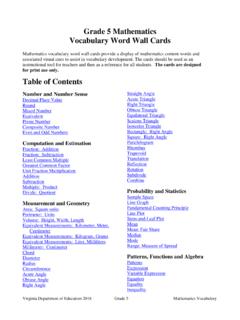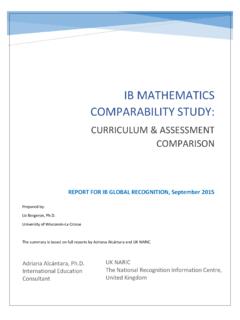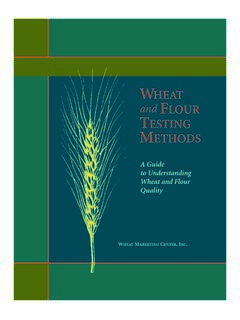Transcription of National LGBT survey: research report - GOV.UK
1 Crown copyright 2018. This publication is licensed under the terms of the Open Government Licence except where otherwise stated. To view this licence, visit or write to the Information Policy Team, The National Archives, Kew, London TW9 4DU, or email: Where we have identified any third party copyright information you will need to obtain permission from the copyright holders concerned. Reference: GEO RR001. ISBN: 978-1-78655-671-4. This publication is available at: Any enquiries regarding this publication should be sent to us at: Government Equalities Office Department for Education Piccadilly Gate Store Street Manchester M1 2WD. National lgbt survey Contents 1 Introduction 4. 2 Methodology 5. survey design and format 5. Dissemination of the survey 6. Response to the survey 6. Data processing and analysis 7. Interpreting the findings 10. Methodological notes 11. Terminology 12. 3 Characteristics 14. Overview 14. Sexual orientation 15.
2 Gender identity 16. Intersex 17. Age 17. Relationship status 20. Ethnic group 21. Religion or belief 22. Disability 23. Education 24. Personal income 25. Place of residence 26. 4 Being lgbt in the UK 27. Overview 27. Life satisfaction 28. Comfort being lgbt in the UK 30. 1. National lgbt survey 5 Safety 32. Overview 32. Openness in personal life 34. Avoidance behaviours 41. Experiences relating to people lived with 54. Experiences relating to people not lived with 66. Private sexual images shared without consent 77. Conversion therapy 83. Reporting crime and accessing support services 95. Sex work 96. Online spaces 97. Blackmail 98. 6 Education 99. Overview 99. Sexual orientation and gender identity in education 100. survey respondents in education 109. Openness in education 110. Experiences in educational institutions 118. Tertiary education 125. Faith schools 126. Special educational needs 127. Teachers 127. 7 Workplace 130. Overview 130.
3 survey respondents in employment 131. Openness in the workplace 137. Experiences in the workplace 149. 2. National lgbt survey 8 Health 161. Overview 161. Public healthcare 163. Mental health 178. Sexual health 191. Elderly and youth in care 206. Blood donation 209. Fertility treatment 209. Substance abuse/misuse 210. 9 Gender transition, legal recognition, and gender identity services 212. Overview 212. Transitioning 215. Gender recognition process 217. Gender identity services 222. 10 Intersex 234. Overview 234. Intersex respondent characteristics 235. Experiences of public healthcare services 239. Experiences of mental health services 243. Experiences of sexual health services 246. 11 Free-text findings 251. Overview 251. Rights and the law 252. Home and abroad 256. Public services, funding and training 258. Experiences of being lgbt 260. Community and pride 261. Information, media coverage and visibility of lgbt issues 262. Religion 264.
4 Sport 265. The National lgbt survey 266. Annex 1: Glossary 267. Annex 2: Questionnaire 271. 3. National lgbt survey 1 Introduction The UK has made significant progress in recent years to further equality for lgbt . people. From the partial decriminalisation of homosexuality 50 years ago to the introduction of same-sex marriage in 2013, successive governments have made remarkable progress in advancing equality for lgbt people. lgbt people can now enjoy the right to marry, to start a family, and to change their legal gender to match their identity. Equality in law, however, does not guarantee equality in everyday life. In 2016, the National Institute of Economic and Social research (NIESR) reviewed existing evidence on the inequalities facing lgbt people in the UK, and revealed that lgbt people continue to face hate crime, higher inequalities in health satisfaction and outcomes, and discrimination, bullying and harassment in education and at work.
5 NIESR also found that there was a lack of data disaggregated by sexual orientation and gender identity, and that the available data was neither robust nor representative To address the remaining inequalities faced by lgbt people, it is important to know what affects them. The Government Equalities Office launched a National lgbt . survey in July 2017 in order to develop a better understanding of the lived experiences of lesbian, gay, bisexual and transgender people, and people who identify as having any other minority sexual orientation or gender identity, or as intersex. The survey was open for 12 weeks and received 108,100 valid responses through an anonymous online questionnaire that collected the experiences and views of individuals who self-identified as having a minority sexual orientation or gender identity, or as intersex, and were aged 16 or above and living in the UK. The survey placed an emphasis on issues relating to personal safety, education, the workplace and healthcare.
6 These were selected because existing evidence on the experiences of lgbt people and their life outcomes tells us that these are the main areas in which inequalities exist. The survey also sought to gather transgender respondents' experiences of transitioning and of accessing and using specialist gender identity services, as well as the experiences of intersex respondents. The findings of the survey are presented in this report . 1 National Institute of Economic and Social research , Inequality among lesbian, gay, bisexual and transgender groups in the UK: a review of evidence', July 2016. 4. National lgbt survey 2 Methodology The Government Equalities Office launched the National lgbt survey on in July The survey was open for 12 weeks. The target group of the survey was defined as people who: self-identified as lesbian, gay, bisexual, transgender or as having another minority sexual orientation or gender identity, or as intersex were 16 years old or above lived in the United Kingdom The survey covered a range of issues relating to the everyday lives of lgbt people, including personal safety, education, the workplace and healthcare.
7 survey design and format To design the survey questionnaire, the Government Equalities Office reviewed good practice guidance from various organisations and consulted policy experts from across government, civil society organisations, academics, and a number of other relevant stakeholders. The survey questionnaire was reviewed by some of these groups before the survey was launched publicly to ensure that it was easily navigable, understandable, and had an appropriate length. The survey predominantly consisted of closed single-response and multiple-response questions; however, respondents also had the opportunity to provide further details about their experiences, views and perceptions as lgbt people in an optional free- text question at the end of the survey . The Government Equalities Office chose to conduct an online survey as this presented an effective way of reaching as many lgbt people as possible. The lack of National and administrative datasets holding data on sexual orientation or gender identity meant that it was not possible to use standard sampling methods to gain a representative sample of lgbt people.
8 Running the survey online also provided a way for respondents who were less open, or not open, about their sexual orientation or gender identity to share their experiences and views in an anonymous and confidential way. In addition, the provision of privacy and confidentiality sought to make respondents feel comfortable in providing details of sensitive or negative experiences. 2 Government Equalities Office, National lgbt survey ', last updated 26 September 2017. 5. National lgbt survey A shorter, easy read' version of the survey was also made available on to allow those with learning or other disabilities to participate. In order to ensure that people who started the survey were eligible to proceed ( identified as lgbt , were aged 16 or above, and lived in the UK), screening questions, in addition to a written reminder of the target group, were used at the start of the survey to verify respondents' age, location, sexual orientation and gender identity.
9 The full questionnaire is provided at the end of this report (Annex 2: Questionnaire). Dissemination of the survey The survey was promoted via stakeholders, at Pride events, through National media coverage, and through the Government Equalities Office's and other government social media channels. The launch of the survey was also publicised by the Minister for Women and Equalities during several television interviews and in an online video as part of National Pride celebrations. Response to the survey The survey received 108,100 valid responses, which included 32,715 responses to the optional free-text question at the end of the survey ( table ). A number of invalid responses, such as those by people who were under the age of 16 or who did not identify as lgbt , were made but excluded from the dataset. In addition, a number of responses were made that were purposefully offensive, abusive, explicitly vulgar, or otherwise unreliable, such as responses admitting not being from someone who identified as lgbt or that were aimed at undermining the survey .
10 These responses were identified by examining the responses to all questions with an other, please specify' option, as well as responses to the optional free-text question at the end of the survey . table : Responses to the National lgbt survey Total (rounded). All responses 118,420. Not eligible, not lgbt , not 16 or above, or not living in the UK 7,360. Offensive, abusive, explicitly vulgar, or otherwise unreliable 2,970. Valid responses 108,100. Valid responses to the optional free-text question 32,720. 6. National lgbt survey Data processing and analysis Quantitative data Respondents were able to specify their own sexual orientation and gender identity if they wished in a free-text box. These responses were coded and the more common answers grouped into new categories. This process resulted in the creation of three additional sexual orientation categories to those originally listed on the questionnaire (asexual, pansexual and queer).















